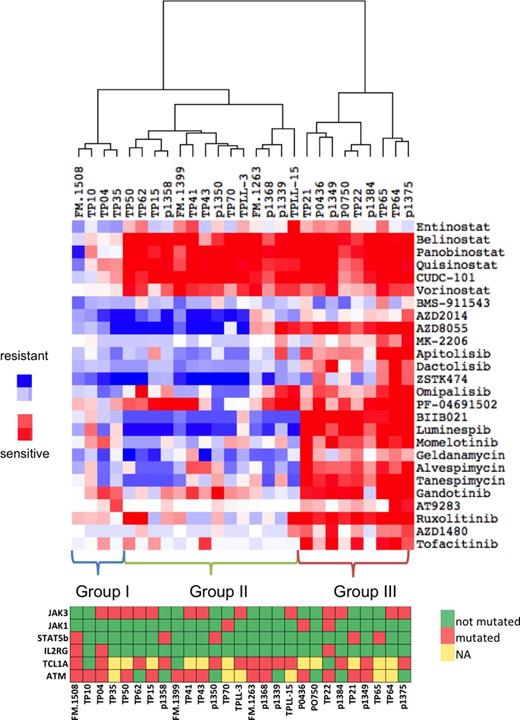Abstract
T-cell prolymphocytic leukemia (T-PLL) is a rare disease with an aggressive clinical course and a median overall survival of less than three years. Although almost 75% of T-PLL patients are reported to harbor translocations causing the activation of the proto-oncogene TCL1A, T-PLL is genetically heterogenous: most T-PLL patients also have mutations or deletions in the ATM gene and the genes involved in the JAK-STAT pathway are mutated in 76% of cases. There is an urgent need for more rational based therapies, but clinical trials are difficult to perform due to the rareness of the disease. Here, we systematically explored the diversity of drug responses in T-PLL patient samples ex vivo using a drug sensitivity and resistance testing (DSRT) system including 306 oncology drugs (approved or investigational). We also aimed to determine any associations between the genetic aberrations and drug sensitivities in T-PLL patients.
Primary mononuclear cells were gathered from 30 T-PLL patients for drug testing. Cells were plated in 384-well plates and subjected to the 306 substances using a 10,000-fold concentration range. After 72 hours, cell viabilities were measured, the results were depicted as dose-response curves for each compound, and differential drug sensitivity scores (sDSS), representing leukemia-specific responses, were computed by comparing patient samples to healthy donors. Drug response profiles across patients were clustered and visualized by hierarchical clustering. The subgroups resulting from the clustering were statistically compared using a two-sample t-test to understand which drug classes were driving the grouping.
To delineate heterogeneous pathway dependencies, drug sensitivities were correlated with somatic genetic variants and recurrent chromosomal aberrations. Genetic characterization was performed by targeted amplicon sequencing of tumor cells to profile known recurrent genetic variants (STAT5b, IL2RG, JAK1, JAK3, ATM). Information on chromosomal aberrations (TCL1A translocations, ATM deletions) was derived from parallel clinicopathologic databases.
Amplicon sequencing revealed that 70% of T-PLL patients (21/30) harbored a mutation in genes involved in the JAK-STAT pathway (JAK1, JAK3, STAT5b or IL2RG). The most prevalent mutation led to an M511I amino acid exchange in the JAK3 protein (26% of patients). Interestingly, the STAT5b mutations (5/30) did not coexist with any of the JAK mutations in our cohort.
Based on DSRT analysis, all T-PLL samples were sensitive to the CDK-inhibitor SNS-032 and the anti-cancer antibiotic actinomycin D. Next, we clustered patients using sDSS values for all 306 different substances, and this showed that patient samples could be divided into 3 main groups, based on their drug responses (Figure). According to two-sample t-test, the grouping was driven by the selective sensitivities of Groups II and III to HDAC inhibitors (belinostat, panobinostat, quisinostat, CUDC-101 and vorinostat) and the selective sensitivity of Group III to PI3K/AKT/mTOR inhibitors (AZD-8055, MK-2206, apitolisib, dactolisib, PF-04691502, ZSTK474, and omipalisib), HSP90 inhibitors (BIIB021, luminespib, alvespimycin, and tanespimycin) as well as JAK inhibitors (ruxolitinib, momelotinib, tofacitinib, gandotinib). Group I samples were on the other hand relatively resistant to these classes of drugs. Surprisingly, despite the prevalence of the signature event of activation of TCL1 (the established AKT coactivator) in nearly all cases, only a subset of cases (group III) responded to PI3K/AKT/mTOR inhibitors. Strikingly, the grouping of selective responses to HDAC, JAK, PI3K/mTOR/Akt and HSP90 inhibitors did not link to the presence of JAK/STAT mutations, TCL1A translocations, or ATM deletion status.
Ex vivo drug screening of primary T-PLL samples revealed heterogenous selective drug responses in specific drug classes (such as HDAC-, JAK-, HSP90- and PI3K/Akt/mTOR-inhibitors). Surprisingly, the drug response patterns did not correlate with known recurrent genetic aberrations suggesting that sequencing for recurrent genetic biomarkers cannot easily be turned into effective therapeutic strategies in T-PLL, and that further elucidation of the biological pathways driving T-PLL is needed.
Mutation status and clustering of HDAC-, PI3K/mTOR/Akt-, HSP90-, and JAK-inhibitor responses in PLL patients based on sDSS values
Mutation status and clustering of HDAC-, PI3K/mTOR/Akt-, HSP90-, and JAK-inhibitor responses in PLL patients based on sDSS values
Koschmieder:Novartis: Consultancy, Honoraria, Membership on an entity's Board of Directors or advisory committees, Other: Travel reimbursement for scientific conferences, Research Funding; Novartis Foundation: Research Funding; Baxalta/CTI: Membership on an entity's Board of Directors or advisory committees; Sanofi: Membership on an entity's Board of Directors or advisory committees; Janssen Cilag: Other: Travel reimbursement for scientific conferences ; Pfizer: Consultancy, Honoraria, Membership on an entity's Board of Directors or advisory committees, Other: Travel reimbursement for scientific conferences. Wennerberg:Pfizer: Honoraria, Research Funding. Ding:Merek: Research Funding. Mustjoki:Pfizer: Honoraria, Research Funding; Bristol Myers Squibb: Honoraria, Research Funding; Novartis: Honoraria, Research Funding.
Author notes
Asterisk with author names denotes non-ASH members.


